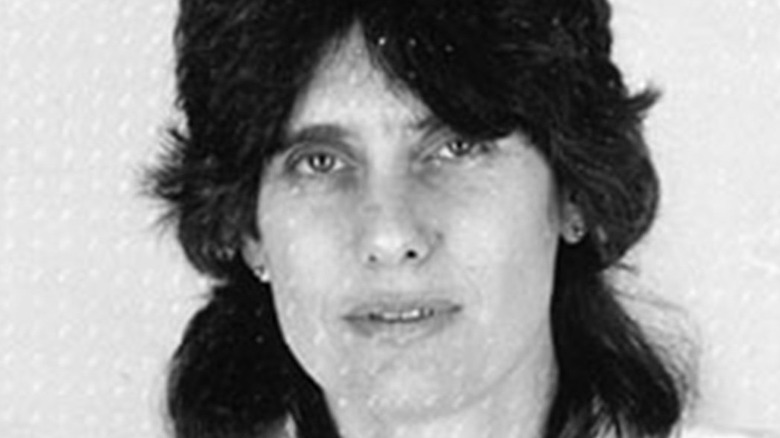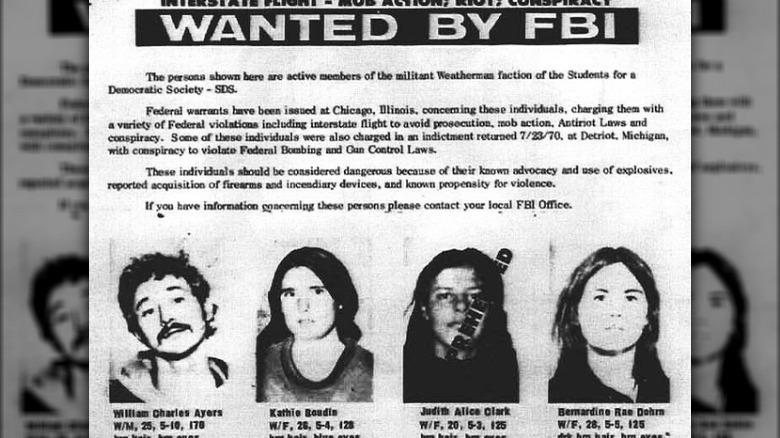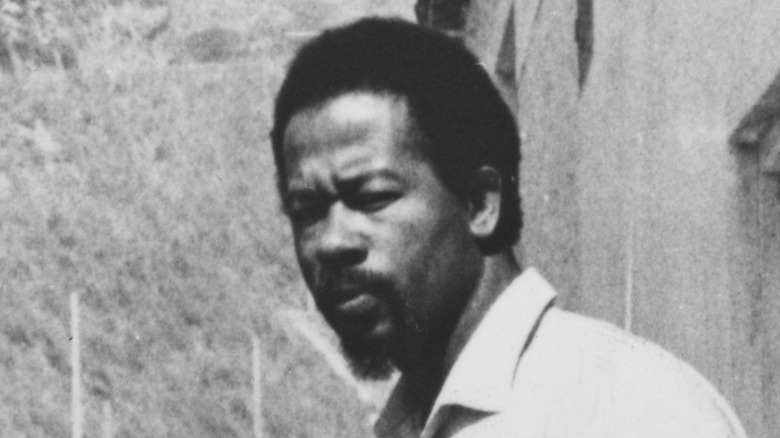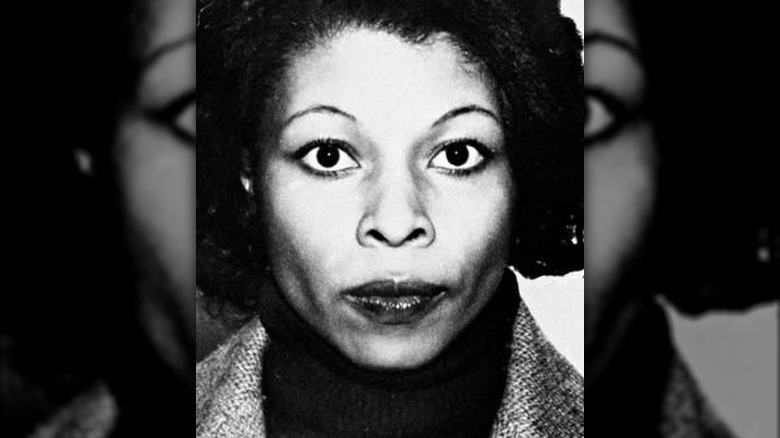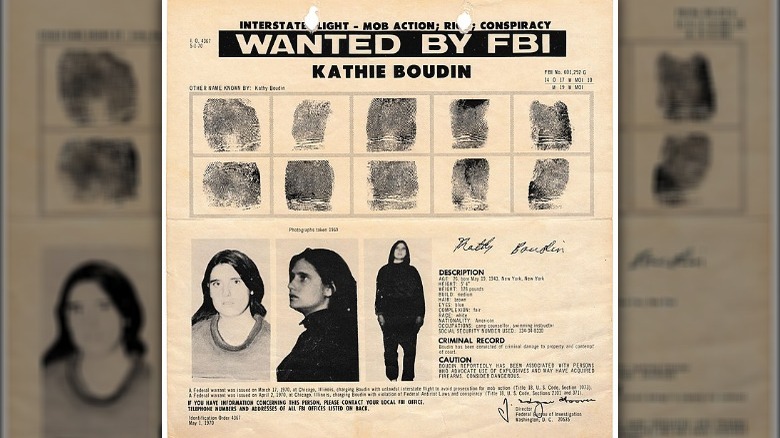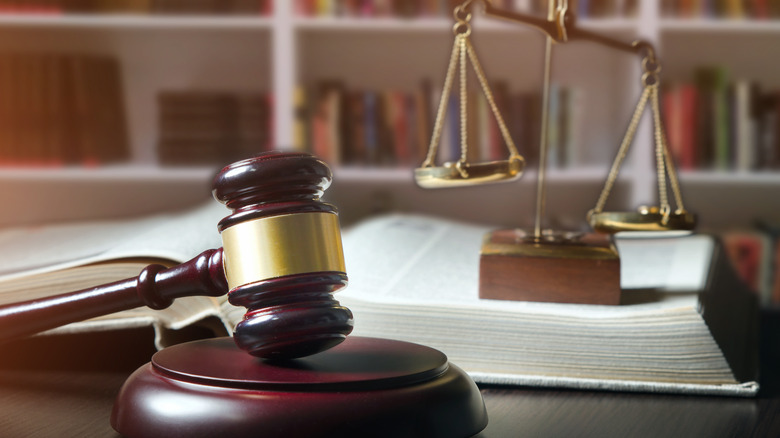The Relationship Between The Weather Underground And The Black Liberation Army
The 1960s were a time of great social and political upheaval in the United States and around the world, spurred in no small part by the war in Vietnam. As a result, a number of community and grassroots organizations came together to oppose the conflict and to work for social change. Many such groups were led by student radicals who embraced Marxist philosophy, like the Weather Underground. Alongside Weather Underground, groups like the Black Liberation Army, also left-wing, were led by people of color fighting for Civil Rights, among other objectives.
Some activist organizations such as these chose peaceful and nonviolent protest, while others turned to direct action and violence. Because of this, many young revolutionaries who belonged to these groups went underground in the '70s, according to NPR. One such example is the former Weather Underground member Kathy Boudin (pictured), who died from cancer in 2022 (via The Guardian). The relationship between the Weather Underground and the Black Liberation Army offers a fascinating look at this tumultuous period.
What was the Weather Underground?
Per the FBI, the Weather Underground, once called the Weathermen, was a small splinter group of the Students for a Democratic Society (SDS). Formed in 1969, the Weather Underground differed from the SDS — by that point, no longer active — in their belief that anti-war, anti-racist, and anti-imperialist objectives could be achieved only through violence. In just one year, the Weather Underground claimed responsibility for more than two dozen bombings around the U.S., and at high-profile locations such as the Pentagon and a New York City police station, among others.
Similar forms of direct action and violent confrontation with authorities continued from the Weather Underground into the 1970s. By that point most members were on the run or living as fugitives. By 1974, the Weather Underground was one of few similar groups still active who believed in and perpetrated violent protests (via Britannica). Another such group was the Black Liberation Army, which like the Weather Underground advocated for and carried out armed resistance (via NPR).
What was the Black Liberation Army?
Founded around the same time as the Weather Underground, the Black Liberation Army (BLA) was a violent offshoot of the Black Panthers, according to NPR. There's some question to this day how formally organized the group really was. With many similar objectives to the Weather Underground, the BLA, founded in part by former Black Panther leader Eldridge Cleaver (pictured), were particularly concerned with what they perceived as excessive police violence against people of color. The militant group felt the only response was to kill police officers in retaliation (via Cengage Learning).
Throughout the early 1970s, members claiming affiliation with the BLA carried out several such attacks, such as the brutal killing of two New York police officers in 1972. Also similar to the Weather Underground, members purportedly linked to the BLA were on the run and living as fugitives by the '70s. In the waning years of the Vietnam war each group sought to redefine themselves, especially after the peace treaty was signed between the U.S. and Vietnam in 1973. From that point forward, the Black Liberation Army — along with a few other groups, such as the Weather Underground and the Symbionese Liberation Army, continued to advocate for armed resistance.
How were the Weather Underground and the BLA connected?
By the 1970s the BLA and the Weather Underground were among the few anti-war activist groups still active. Between the two groups there was common cause, as each sought to accomplish similar ends through violent confrontation and other forms of direct action, as Cengage Learning explains. Both groups primarily saw themselves waging direct revolution against the American government. The police officer killings at the hands of the BLA soon grew too much for the Weather Underground, though. As a result, the Weather Underground, once allied with many Black revolutionary groups, began to distance itself from the BLA (per NPR).
Nevertheless, members of the BLA continued to attack, capture, and kill police officers. By the mid-1970s, many leaders aligned with Black Liberation Army were captured or killed by law enforcement agencies. The BLA's last leader, Joanne Chesimard, also known as Assata Shakur (pictured), fled to Cuba, while many members of the Weather Underground, including University of Chicago law professor Bill Ayers and Kathy Boudin, were on the run (via The Hill). By the late 1970s and into the early 1980s, some charges against the Weather Underground were dropped. As a result, several members of the Weather Underground emerged from hiding.
The 1981 Brink's Robbery
The biggest example of the alleged members of the Black Liberation Army and members affiliated with the Weather Underground came in the so-called Brink's Robbery in 1981, the crime for which former Weather Underground member Kathy Boudin would serve more than two decades in prison. It was also one of the last criminal incidents perpetrated by either group. The plan was for an armored vehicle to be robbed and money stolen. That cash would then be redistributed to support a number of causes affecting people of color.
While the robbery itself would be carried out by alleged members of the Black Liberation Army, the getaway car would be driven by Boudin and another Weather Underground member named David J. Gilbert, with whom Boudin had a child. Both Boudin and Gilbert were already wanted fugitives for their connection to bank robberies and other criminal activity perpetrated by the Weather Underground. In the ensuing melee, shots were fired and three people were killed. Boudin served 22 years in prison, described as a model prisoner who expressed remorse for her crimes, and was paroled in 2003 on good behavior. Gilbert's sentence was commuted by former New York Governor Andrew Cuomo. He was granted parole in October 2021 and released the following November (per NBC New York). Several BLA members evaded capture. Some were later arrested, according to the Crime Library.
The San Francisco 8
The largest arrest of members affiliated with the Black Liberation Army came much later, in 2007. At that time, eight men who came to be known as the San Francisco 8 were accused of killing Sgt. John Young, in August, 1971. One man involved in the killing was still wanted at the time of the arrests. The men who came to be known as the San Francisco 8 were also believed to be involved in a number of Bay Area police killings and bank robberies from that era, a time during which seven San Francisco officers died, per SF Gate.
Charges were dropped against five of the eight, while two men pleaded guilty to voluntary manslaughter. Another man involved in the case, Anthony Bottom, pleaded no contest to conspiracy to commit voluntary manslaughter as he was already in prison. No one from the Weather Underground is accused in these crimes (via SF Gate).
Boudin died of cancer May 1 in New York City. David Gilbert was with her when she died.
